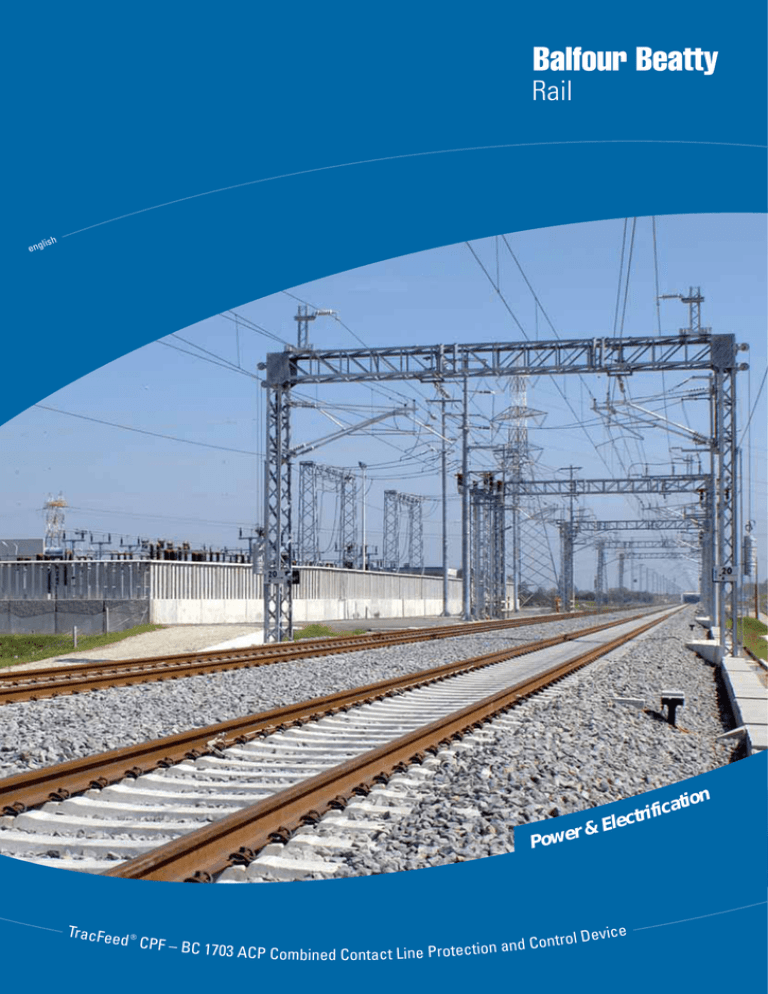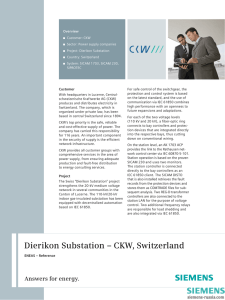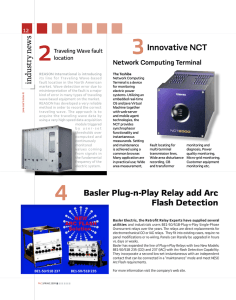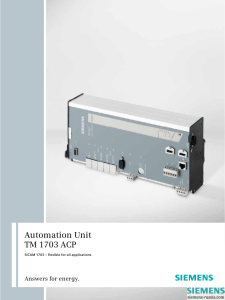
lish
eng
P
TracFee ®
d
&E
owe r
le c
ce
trol Devi
n
o
CPF – BC 17
C
d
n
a
n
03 ACP Combined Contact Line Protectio
at
t rif i c
ion
Application range
Within the TracFeed ® family of railway products,
the combined contact line protection and control
device TracFeed ® CPF is based on the BC 1703 ACP
and designed as a multifunctional device. It can be
used for all common AC railway feeder protection
applications and is suitable for 50 Hz railway systems
of every voltage level, with single or double-phase
traction power supply (autotransformer system).
System architecture
In spite of the integration into one device, protection
and control is designed to work independently from
each other. The BC 1703 ACP is equipped with two
separate CPUs, which achieve almost identical
availability as two separate devices. A redundant
power supply can be equipped as an option.
A scalable hardware, based on common hardware
modules and different housings, provides maximum
flexibility.
A flash card is used for storing the firmware and parameters. Thereby the replacement of devices is performed
simply via Plug & Play. With the flash card, the firmware
and settings are transferred into the spare device. This
means that handling with a PC is unnecessary and the
correct parameters are always on site.
Together with the remote maintenance functions, downtime can thus be reduced to a minimum.
02
System architecture
Function overview
- Common protection functions for typical railway
feeder bays.
- Capability to control all switching devices of a
feeder bay.
- Communication with other protection and control
devices, as well as SCADA systems, via common
protocols in accordance with different protocol
standards (IEC 60870-5-101/103/104).
- Operator panel with alphanumerical keys, function
keys, programmable LEDs and display to indicate
all status information of the relevant feeder bay.
- Service interface at the front panel for local communication with the device via PC or notebook.
TOOLBOX II, the operating programme, allows
comfortable handling of all device functions.
TracFeed ® CPF
Protection
The BC 1703 ACP contact line protection relay features
all protection functions for AC railway overhead lines.
Four different parameter groups can be used completely
independently, to adapt the protection functions to the
appropriate network configuration.
TracFeed ® TAC
Distance protection (21)
The distance protection function is the main function of
the BC 1703 ACP contact line protection relay. It features
a polygonal characteristic with four trip zones and
different forward and backward direction settings.
One function operates as an emergency protection when
the distance protection function is not working effectively.
The second overcurrent protection function can be used
independently from the distance protection function.
High-speed overcurrent protection (50F)
This function operates as a definite time overcurrent
protection, where the instantaneous values of the
measured current will be monitored.
Thermal overload protection (49)
The BC 1703 ACP contact line protection possesses
a thermal overload protection, which calculates the
temperature of the overhead line based on the feeding
current. An additional outdoor temperature registration
can also be used.
Voltage protection (27, 59)
Polygonal characteristic
The overvoltage protection function detects unwanted
network over-voltage conditions.
The undervoltage protection function provides protection
against dangerous voltage drops.
De-icing protection (87H)
Overcurrent protection (50, 51, 51E)
Two independent overcurrent protection functions are
available with a total of three definite time stages as
well as one definite time/inverse time stage.
De-icing protection can be used to protect the contact
line against short circuits during the de-icing process.
This function compares the outgoing feeder current
with the return current.
Breaker failure protection (50BF)
The BC 1703 ACP contact line protection includes a
two-stage breaker failure protection to detect failures
of tripping command execution.
If a fault can not be cleared upon issuance of a trip
command, a second trip command can be initiated
using the breaker failure protection. Breaker failure
is detected if a current is still running in the faulted
circuit after a trip command. As an option the circuit
breaker position indication can be used.
Switch onto fault protection (50HS)
In the case of switching onto a faulted circuit it is
possible to initiate an instantaneous trip command
independently from all parameterised tripping times.
Synchrocheck function (25)
Where different network sections are switched on by
control or auto-reclosure function, it has to be ensured
that both sections are mutually synchronous. It is precisely for this purpose that the BC 1703 ACP provides
a synchrocheck function, which compares the voltage
of both sections. After verification of the network synchronism, the synchrocheck function releases the close
command for the circuit breaker.
Auto-reclosure function (79)
An auto-reclosure function is included in the BC 1703 ACP
relay. This makes it possible to switch on the circuit
breaker automatically after a protection trip.
Inrush restraint (68)
To avoid unwanted trip commands caused by inrush
currents, the overhead line protection relay provides
inrush restraint. This function monitors the second
harmonic of the measured current. If the value of the
harmonic is above an adjustable threshold, selected
trip commands (except the high-speed overcurrent
protection) will be blocked.
04
Fault locator function (21FL)
The BC 1703 ACP protection relay provides an integrated
fault locator, which calculates the fault impedance and
the distance to the fault.
Trip circuit supervision (74TC)
One or two binary inputs can be used to monitor the
circuit breaker trip coil, including its connected cables.
An alarm will be generated whenever an interruption
of the monitored trip circuit occurs.
Event recorder
The BC 1703 ACP contact line protection relay provides different memories to store an operational indication list and a disturbance indication list, as well as
several disturbance records, which can be monitored
with the TOOLBOX II operating and analysis software.
Switching authority
Control and supervision
Command processing
In addition to the protection functions the BC 1703
ACP contact line protection relay supports all control
and monitoring functions that are required for railway
feeder applications.
The switching authority will be determined according
to parameters, communication or key-operated switches.
If the relay is set to local operation only local commands
will be carried out. Remote access will be denied in
this status.
All standard functionality of command processing as
single and double commands with or without feedback, monitoring of control software and hardware
and automatic command termination is offered.
Programmable logic functions
Control operations
All control operations can be carried out using the control panel of the relay, via the remote communication
connection or via the operating programme.
By the use of integrated logic functions, which
can be set by a graphic editor, it is possible
to build specific functions for substation
automation. The graphic editor is part
of the operating programme software
package, TOOLBOX II.
Key-operated switch
The BC 1703 ACP relay provides two key-operated
switches. One for changeover between remote, local
and test operation, and the second to disable bay
interlocking.
Interlocking functions
All necessary interlocking functions for bay interlocking,
as well as overall substation interlocking, can be
handled by the BC 1703 ACP relay.
05
Engineering and maintenance
Communication
The combined contact line protection and control device
is equipped with different serial communication ports
for different protocol types to enable communication
with other protection devices, as well as to perform
the remote communication to the station control and
to the remote control centre.
Communication interfaces are available for electrical
communication links and optical communication cables.
Communication can be achieved by IEC 60870-5-101,
103 and 104 protocol types, or by different customerdefined protocols. Application of the new standard
IEC 61850 is in preparation.
Configuration possibilities
06
Essential aspects regarding overall economy are the
costs that arise from engineering and maintenance.
The high-quality programme TOOLBOX II is used for
this.
All parameter settings, interlocking and logical functions, as well as maintenance and disturbance analysis,
can be performed by this tool.
Control and interlocking functions are designed by means
of CAEx plus, in accordance with the IEC 61131-3.
Close coupling with the CAD tool guarantees consistent
and seamless documentation.
All engineering activities can also be carried out with
TOOLBOX II remotely.
The BC 1703 ACP relay has separated data models for
the protection and control functionality, which can also
be parameterised separately from each other.
Compact housing
with display panel
Compact housing
rear view
Modular housing
rear view
Technical Data
Size:
Unit design:
Degree of protection:
Terminals:
Display panel size:
LED indication:
Controls:
Supply voltage:
Control voltage:
Number of controlled devices:
I/O signals:
Product standard:
Isolation:
EMC:
Mechanical robustness:
Environmental conditions:
(in operation)
280 x 220 x 260 (H x W x D) (Compact housing)
266 x 483 x 251 (H x W x D) (Modular housing)
surface mounting housing, flush mounting housing,
19”-rack (Modular housing only)
IP 62 acc. to IEC 60529
screw terminals up to 2.5 mm2 (CT connections up to 6 mm2)
70 x 120 (W x H); 240 x 128 pixels
(illuminated with LEDs, automatically switch on/off)
1 x operation; 2 x disturbance
(separately for protection and control)
10 x protection indications (programmable)
9 x control indications (programmable)
2 x key-operated switches
numerical keys (0–9, comma and algebraic sign)
different function keys
TOOLBOX II interface 1 x D-SUB 9-pin
24–60 VDC; 110/220 VDC +30/–20%
115–230 VAC +10/–20%
110/220 VDC; 48/60 VDC +30/–25%
up to 10 (Compact housing) or more (Modular housing)
up to 72 (Compact housing) or up to 500 (Modular housing)
IEC 60255
IEC 60255-5, IEC 60870-2-1, DIN 57435-303, EN 50124-1
IEC 60255-6 and -22, EN 61000-6-2, DIN VDE 0435-110,
DIN 57435-303 and EN 50121-5
IEC 60255-21 and IEC 60068
temperature range: –20 °C to +70 °C,
–10 °C to +70 °C (display legible)
Humidity: 5–95% non condensation
07
08/06 Printed in Germany BBRPS/037-e
Balfour Beatty Rail GmbH
Power Systems
Garmischer Str. 35
81373 Munich
Germany
Tel. +49 (0) 89 4 19 99-0
Fax +49(0) 89 4 19 99-270
info.bbrps.de@bbrail.com
Copyright © 2006. Balfour Beatty Rail GmbH. All rights reserved. No part of this publication
may be reproduced without the permission of Balfour Beatty Rail GmbH. The information
in this document contains general descriptions of the technical possibilites, which may not
be available in every case. The required performance characteristics should therefore be
specified individually when a contract is concluded.
TracFeed ® is a registered trademark of BICC Holdings GmbH.
www.bbrail.de
Balfour Bea†y is a registered trademark of Balfour Beatty plc.





